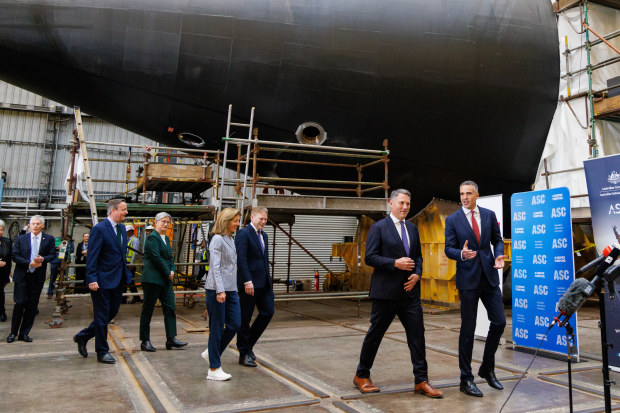Rule Britannia: How Australia’s military future relies on one UK firm

In naming BAE Systems as the builder of Australia’s AUKUS-class submarines, the Albanese government is putting all its major shipbuilding eggs in the British defence giant’s basket.
BAE Systems is already Australia’s biggest defence contractor, employing about 6000 people and with reported revenue of $1.8 billion in 2023, according to corporate records.

At the Osborne Naval Shipyard in Adelaide on Friday were (from right) South Australian Premier Peter Malinauskas, Defence Minister Richard Marles, UK Secretary of State for Defence Grant Shapps, US ambassador Caroline Kennedy, Foreign Affairs Minister Penny Wong and UK Foreign Secretary David Cameron. AAP
While BAE’s origins are in aerospace, its aviation work in Australia is largely limited to supplying the Hawk training fighter jet and maintaining F-35 fighter jets.
BAE’s biggest export success story is the Nulka decoy rocket, which is fitted to Australian, US and Canadian warships. When an enemy missile is fired at a ship, Nulka is launched and hovers in midair, luring the missile away from its target.

The company operates the Jindalee Operational Radar Network, Australia’s crucial early warning system for the nation’s northern approaches that can detect objects thousands of kilometres away at sea and in the air.
But BAE’s focus on Australia is increasingly maritime. It built blocks for Hobart-class air warfare destroyers, and will build the navy’s 10,000-tonne Hunter-class frigates in Adelaide.
After the submarines, the future frigates are Australia’s second-most expensive defence project, but have suffered from delays, design issues, cost blowouts and criticism they are undergunned for a ship of their size.
With the recent navy review finding the total project cost had ballooned to $65 billion from almost $45 billion, the government cut back the number of frigates that will be built from nine to six.
For a project that was originally promised to have a “cut steel” date of 2020, the whiff of trouble has left the Hunter-class frigates with few public defenders.
Despite the setbacks, the reality is there was no other option for the Albanese government but to name BAE Systems as the partner to build nuclear-powered submarines locally.
Under AUKUS, the submarines to be built in Adelaide will be based on the British replacement design for the current Astute class.
The one concession Britain has offered Australia is that the new submarine will be fitted with a US weapons and combat system. That is a big step for the Brits, given the impact it will have on its local industry, and will require more design changes than otherwise would have been planned if the Royal Navy simply updated the Astute-class design.
But the British submarine is in troubled waters. Retired rear admiral Peter Briggs, who led the team that got the Collins-class submarine back on track 25 years ago, last month warned the start date for the first AUKUS submarines was at risk of slipping because Britain’s priority was finishing the remaining Astute-class boats and then its Dreadnought-class submarines.
British Defence Secretary Grant Shapps confirmed in Canberra on Thursday that the Dreadnoughts were Britain’s “most significant national program, bar nothing” – understandable given they will carry nuclear warheads, the core of the UK’s nuclear deterrence.
With both the UK and US submarine production lines struggling, funnelling billions of dollars to subsidise them has been Australia’s price of entry to the AUKUS club.
To make AUKUS succeed, the Defence Department will have to give up its “customer from hell” attitude to contracts.
The monarchy and the Ashes aside, with Australia becoming even more dependent on BAE Systems, the company’s local offshoot has become too big to fail. Taxpayers and the government are left with little leverage if things go wrong.
Subscribe to gift this article
Gift 5 articles to anyone you choose each month when you subscribe.
Subscribe nowAlready a subscriber?
Introducing your Newsfeed
Follow the topics, people and companies that matter to you.
Find out moreRead More
Latest In Federal
Fetching latest articles